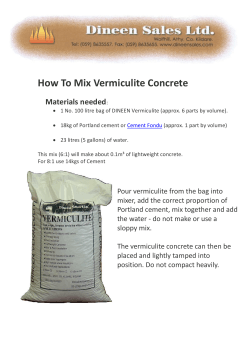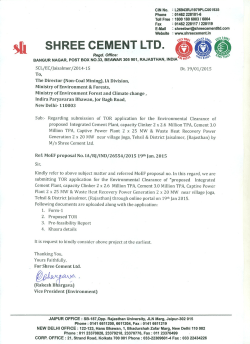
Dhruva Nathan - The Canada-Japan Co
Canada-Japan Co-op Program Experiential Report Internship Period: September 2012 – April 2013 Taiheiyo Cement Corporation 2-4-2 Osaku Sakura, Chiba, Japan, 285-8655 http://www.taiheiyo-cement.co.jp/english/ Dhruva Nathan University of Waterloo Nanotechnology Engineering April 22, 2013 Table of Contents Company Introduction……………………………………………………......................... 2 Work Environment………………………………………………………………………….. 2 Roles and Responsibilities………………………………………………………………... 3 Living Conditions…………………………………………………………......................... 5 Cultural Experience………………………………………………………………………… 6 Recommendations for Students…………………………………………........................ 7 Conclusion……………………………………………………………………..................... 8 Company Introduction Taiheiyo Cement Corporation itself is the result of mergers of several companies starting as early as 1927. The name Taiheiyo Cement Corporation was born officially in 1998 with a merger between Nihon Cement and Chichibu-Onoda Cement. More than its name implies, the company is broken down into four sectors: cement, mineral resources, environment, and international business. Altogether the company possesses over 1500 employees and 19 cement plants, both domestically and abroad. The company has developed a positive reputation worldwide for their efforts in global warming prevention and waste recycling. Particularly, in the wake of the 2011 Tohoku earthquake and tsunami, the company has received appraisal for burning large amounts of tsunami rubble and reusing it in concrete mixtures. Work Environment Taiheiyo Cement Corporation’s Research and Development (R&D) Center is located in Sakura City, Chiba Prefecture. It is located approximately 50km from central Tokyo. Construction of the R&D Center was completed in 1991 and the property is about 60000 square meters wide. The 6 departments present at the R&D Center are Management, Cement & Concrete, Mineral Resources, Production & Environment Technology, Ceramics & Electronics Business, and Research Management. The Construction Technology Team, under which I was employed, is part of the Cement & Concrete department. It consists of 8 members, each with varying educational backgrounds and research interests. The first thing I noticed was how welcoming and approachable each member of the team was, willing to stop and help whenever needed and regardless of how busy they were. They were also quick to help me become familiarized with the research centre, and even went so far as to provide a tour of one of the company cement plants, as shown in Figure 1 below. 2 Figure 1: Supervisor, myself, and department leader on a cement plant tour Since a very large variety of labor goes on at the R&D Center, safe conduct is heavily enforced. Normally, before a group sets about their work day, they will assemble quickly and discuss all the possible hazards and risky tasks before them. The amount of work-related injuries is thus very small. As long as one follows the safety directives, it is possible to feel very safe in all aspects of the workplace. As an intern, you all almost never be working by yourself, so there will always be a senior member of the company responsible for your safety. Roles and Responsibilities The Construction Technology Team discussed above is further divided into two research groups. The first is working to develop a concrete health monitoring system using radiofrequency identification (RFID). By embedding wireless RFID tags into concrete structures, it is possible to unintrusively obtain information about corrosion and chemical damage using an external reader. The project aims to further develop this technology, as well as to spread its use throughout the concrete industry. The second division of the team, for which I was employed, is engaged in the 3 improvement of, and the development of new applications for, fiber-reinforced concretes (FRC). While the research conducted within the group is varied, the particular project I was involved in was an evaluation of the effect of curing conditions on the mechanical properties of FRC. Curing conditions refer to the environment and temperature in which freshly poured concrete sets. This was done by performing various mechanical tests on FRC test pieces, cured at three different standard temperatures (10ºC , 20 ºC, and 30 ºC) for various lengths of time (from 1 day to 91 days). The actual work required for this goal was both physical and analytical. The project was done together with myself, another intern, and the guidance of two senior members of the Construction Technology Team. While the actual fabrication of the test pieces was performed by contractors, we were largely responsible for handling them for the rest of the process. This included cutting, weighing, and preparing the samples for testing; operating the test apparatus and software; properly disposing of used samples; and collection and presentation of results at regular meetings. The most important test we conducted is called the “notched beam test,” which involves cutting a notch into the bottom face of a rectangular concrete beam, and then applying loads to the top face such that the beam cracks and opens outwards. The apparatus setup is illustrated in Figure 2 below. This test reveals the relationship between crack opening width and applied load, and from this it is possible to calculate the fracture energy of the sample. Figure 2: Experimental apparatus for notched beam test An interesting observation is that with FRC, the maximum sustainable load actually increases after the beam initially cracks. Unlike traditional concrete, the load is simply transferred to the steel fibers embedded within, which are collectively able to withstand a higher load. For this reason, FRC is not only much stronger than traditional concrete, but it 4 also has an extremely long warning period before complete failure. This test was performed on FRC simultaneously with two others: a compression test and a splitting tensile test. While these latter two were again performed by contractors, the interns were responsible for handling the data obtained. Through computation of the results from these three experiments, it was possible to extract various interest properties about each specimen such as fracture energy, Young’s Modulus, crack formation strength, and autogenous shrinkage level. Through this work I was able to reflect upon the studies I have done at university, as well as to expand upon my knowledge of materials science to composite materials such as concrete. I also have a particular interest in materials characterization techniques, so it was very rewarding for me when we got the chance to characterize our own FRC samples using X-ray Diffraction Analysis. Figure 3: Fellow intern, team leader, and myself performing X-ray analysis on concrete samples Living Conditions While my place of work was in Sakura City, I stayed in the company’s residence in Yachiyo City. Taking the train to work every day, and also living close to Tokyo, I was able to get a taste of so many different aspects of the Japanese lifestyle. The company residence, a system which is not very common on North America, is very much like a typical university residence. Each resident receives a personal room, and is able to use the 5 shared facilities at any time: washrooms, laundry machines, showers, and kitchens. The rooms are western-style and come with a bed, desk, dresser, closet, deck, and heater-air conditioner. The residence is also within walking distance to the train station, and literally seconds away from a grocery store and convenience store. There is also a cafeteria in-house, proving breakfast and dinner on weekdays. The meal cost is automatically subtracted from one’s salary, rather than having to pay in cash, so eating is quick and hassle free. The staff at the cafeteria was also very generous in accommodating my vegetarian diet. Cultural Experiences I learned quickly that one of the easiest ways to mingle with new people is through sports. One of the first things I did when I arrived to Japan was to join a Kyudo club. Kyudo is a form of Japanese-style archery with roots tracing back many hundreds of years. Like Judo and other Japanese martial arts, it has a strict ranking system and takes many years to master even the basics. As such, it was not possible to advance ranks in as short a stay as mine, but the instructors and members of the club were very gracious in welcoming me and helping me learn the essentials. I was moved by how dedicated the members were to their sport, taking tens of years to study the etiquette and finesse required for Kyudo, and it made me consider how such dedication must also be useful in work and personal relationships as well. I also participated in soccer with members of the company once a month, as well as badminton in the community once a week. I normally find it hard to address people I have never spoken to before, but I learned that it is very easy and that people are very approachable when you have any common interest, such as sports. As far as sightseeing, I was able to visit many of the places and do many of the things that people imagine when they think of Japan: visiting Mt. Fuji, climbing Tokyo Sky Tree, seeing the Golden Temple, doing Hanami and riding the bullet train. These experiences were all very reminiscent of the natural, historical, and technological beauty that is Japan. 6 Figure 4: About to embark on the bullet train More than anything, these experiences have given me a wonderful appreciation of time. This is something that I had not initially expected to get out of my internship, but having such a large list of things to do and people to see in a short 7 months really made me conscious of how many hours are in a day and how I choose to spend them. I used to be a terrible oversleeper in the morning, but by the second half of my internship I had no problem waking up at the same time every day. In many other ways, I made an effort to make the best use of the time that I had, and I think this will prove beneficial in many aspects of life even after my return to Canada. Recommendations for Students Growing up in a Canadian environment, we develop certain cultural values which are embedded so deeply in us that we consider them common sense. However, it is important to remember to begin your life in Japan without any assumptions of how things are done here. Canadians and Japanese people are both known worldwide as being extremely polite, but you would be surprised to learn just how different the definition of 7 “politeness” is in both countries. For example, there is quite a gap between what topics are considered appropriate for conversation between Canada and Japan. You will also learn a lot about the importance of non-verbal communication after spending some time in your new workplace. Your internship is not only an opportunity to learn about the Japanese language and culture, but also about people and relationships, and should thus be taken as such. For students employed at Taiheiyo Cement Corporation, it would be very useful to have a basic understanding of materials science principles. While the knowledge may not be applied in the physical portion of the job, it will be very useful in data interpretation and report composition later on in your research. The amount of data collected from experiments conducted is very large, so being able to quickly scan and understand the numbers presented to you is an asset, in addition to being able to spot abnormal data. To this end, a strong familiarity with Microsoft Excel, particularly pivot tables, also proved very helpful throughout the internship. Conclusion While this is my third internship since entering university, I can easily say that it been the most rewarding in many aspects. It was very exciting to be able to work in a hands-on environment, contrasting with my previous experiences which were mainly software-oriented. The company was very encouraging and accepting, despite my lack of previous experience in the concrete industry, and assigned work of an appropriate difficulty level accordingly. Since Taiheiyo Cement Corporation is experienced in hiring students from Canada, there is little risk of interns being overloaded with work. I would recommend the company to students in Engineering even if they have very little knowledge of concrete, as the experience leads to possible work in the company’s other research sectors, materials and environment. The cultural experience here in Japan has also been unforgettable. I did not have to go very far at all for sightseeing, as there was no shortage of historical and natural places of interest just within Chiba Prefecture. Moreover, the people I met were extremely kind and welcoming, to the point where it was very difficult to feel homesick. I am strongly inclined to return one day soon, not for the tourism but to see the friends I have made here. I am very grateful to the Canada-Japan Co-op Program staff for their guidance and consideration during the entire year of preparation leading to my internship, as well as for the 7 months I have spent in Chiba. 8
© Copyright 2025









